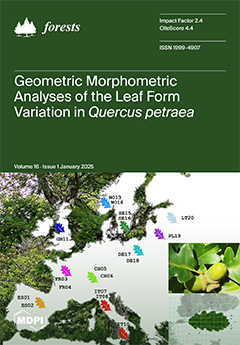In natural saline habitats, the impact of the salt-ion content absorbed by halophytes on their biomass development remains unclear. This research investigated
Poacynum pictum (Schrenk) Baill., a typical halophyte in the Ebinur Lake Wetland Reserve.
P. pictum was collected from three water–salt habitats: high water and high salt (Habitat 1), medium water and medium salt (Habitat 2), and low water and low salt (Habitat 3). This study aimed to quantify the salt-ion content and biomass in different
P. pictum organs, analyze their distribution under varying water–salt habitats, and explore the mechanism of the relationship between salt-ion content and biomass. The results showed the following: (1) With the decrease in water–salt habitats, the Na
+ contents of aboveground organs decreased, whereas root Na
+ content increased. The aboveground organs’ Ca
2+ contents exhibited the ranking Habitat 2 > Habitat 3 > Habitat 1. The Ca
2+ and Mg
2+ contents followed a similar pattern, with leaves showing the highest concentrations, and the Ca
2+ and Mg
2+ contents in roots exhibited a declining trend with the decrease in water–salt habitats. The Cl
− content was predominant in the leaves and stems of all water–salt habitats. This indicates that
P. pictum can maintain an ionic state in the body and resist habitat stress through the separation and absorption of salt ions in different organs. (2) With the decrease in water–salt habitats, the leaf, twig, stem, and total biomass of
P. pictum demonstrated a gradually decreasing trend, and the root biomass initially increased and then decreased. This reveals that
P. pictum can adapt to high–saline habitats and achieve normal growth and development, and that suitable water and salt conditions are important for underground accumulation. (3) The Na
+ content in leaves, twigs, and stems had a significant positive effect on the biomass of these organs, making it the most influential factor, and the root biomass was primarily affected by root Ca
2+. These findings indicate that
P. pictum adapted to saline habitats by adjusting its ion uptake and biomass, and the Na
+ in aboveground organs and Ca
2+ in roots are critical for biomass development in their respective organs. This study provides valuable insights into the adaptation strategies of halophytes in salinized environments and highlights the importance of specific ions’ accumulation for biomass maintenance.
Full article





